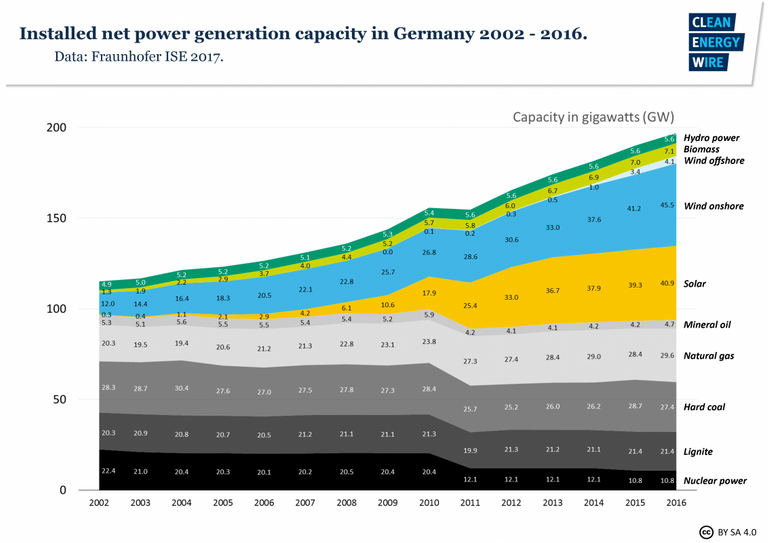Germany does not mess around when it comes to achieving their goals.
I have looked into a few of the US's policy on renewables which mostly consist of tax incentives and low interest loans but the most interesting I've seen is definitely Germany’s Feed-in Tariffs. For those of you who are not familiar with the law, it was introduced in 1990 to help the growth of renewables. With this policy, Deutschland has been able to be in the front of the renewable energy wave that has been popularized in recent years. The way the country decided to incentivize the adoption of renewables made the technology almost a no risk investment. First, people who have renewable energy systems such as solar power or wind can sell the electricity created from their system can sell that to grid. Now, because of the law, grid operators are required to purchase energy that comes from renewables over non-renewables’ power producers like coal. This made sure that alternative energy producers were guaranteed to have their energy bought over cheaper coal plants. While this is already an amazing security for investors in the growing field, that is not the only reason to put money into cleaner fuels.

Shows Germany’s power generation from 2002-2016 in a variety of energy sources.
What made this law so successful was that it gave renewable energy producers the ability to set the price in which their electricity would be sold at and it was guaranteed for twenty years. Investors are not only assured their energy will be purchased but that it will be bought at a consistent price for two decades. People would be able to figure out their return on the investment incredibly easily. Germany made the decision for people who could afford and willing to participate in renewables much safer and more straightforward.
Unfortunately, not everyone is able to take advantage of the policy; cities are where the majority of the population of countries lie and there is limited space in cities to have renewable installations for citizens. Many people only rent an apartment or own a small portion so they have no way to install a system. In addition, renewables have a large up front cost that makes it difficult for many people adopt renewable technology. For this reason it is only obtainable by people with high disposable income to handle the initial cost of a system. Citizens with lower income are unable to take advantage of the policy and to invest in a system and also have to deal with the energy price. Even though not everyone can afford renewable systems; the cost of installing a system has been significantly reduced over the past decade. But, this change did not come with all the benefits people expected, which I will touch on in my next post so look for that. Let me know of any environmental policy you know about and your take on this.
To me this law has done an exceptional job at increasing the number and security of renewable energy projects. While I am no policy expert by any means I do have a few problems with the law. The twenty years assurance is a very long time to have a guarantee for a high payment. It seems like it is that long to entice people to participate and it certainly has done that but why not over the years slowly lower the number of years to keep interest and lower the issues the law has done. There could be an infinite number of reason for keeping the law as it is until it’s most recent amendment in 2017 (I talk of the amendment in a later post).
Regardless of its flaws, the policy has done amazing things for Germany as a whole and helped with their progess toward achiveing the Sustainable Development Goals. Countries have been been attacking issues like poverty, inequality and climate change for some time now and this has come through the Sustainable Development Goals (SDGs). The SDGs have been designed to help the world understand and tackle issues as well as be used to assist in giving projects, laws, and other operations have something to work toward and ensuring actions are benefiting at least one of the Goals. With the Feed-in Tariff, Germany is working toward Goal 7: Affordable and Clean Energy, Goal 8: Decent Work and Economic Growth and Goal 9: Industry, Innovation and Infrastructure. The standards set by the Sustainable Development Goals demonstrate forward thinking, progressive checkpoints and prioritize key areas for improvement for any nation. The Feed-in Tariff wasn’t made with the SDGs in mind but it embodies the same forward thinking, progressive checkpoints and prioritizes key areas for improvement for Germany.
Sources:
Amelang, Soren. "Balancing the books: Germany's "green energy account"." Clean Energy Wire, 12 Feb. 2015,
https://www.cleanenergywire.org/factsheets/balancing-books-germanys-green-energy-account
Appunn, Kerstine. "Defining Features of Renewable Energy Act (EEG)." Clean Energy Wire, 8 Oct. 2014,
https://www.cleanenergywire.org/factsheets/defining-features-renewable-energy-act-eeg
Bohringer, Christoph. "Economic Impacts of Renewable Energy Promotion in Germany." Energy Journal, vol. 38, 2 May 2017, pp. 189-209
Chart Link:
Clean Energy Wire, https://www.cleanenergywire.org/factsheets/germanys-energy-consumption-and-power-mix-charts

Well done Licata. For future ref, you should do small intro paragraphs or titles for your posts. It helps the readers, I think.